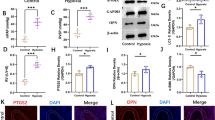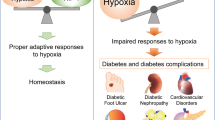Abstract
Background
Intermittent hypoxia (IH) can damage endothelial cells and lead to apoptosis in obstructive sleep apnea-hypopnea syndrome (OSAHS). Hypoxia induces apoptosis in endothelial cells via upregulation of endothelin-1 (ET-1) and hypoxia inducible factor-1 alpha (HIF-1α) plays a key role in the hypoxic stress response.
Purpose
We investigated an approach to diminish the negative effect of HIF-1α while maintaining its protective effect.
Methods
Human umbilical vein endothelial cells (HUVECs) were subjected to sustained hypoxia (SH) or IH for 24 h, and the responses of HIF-1α, CCAAT/enhancer binding protein beta (C/EBP β), and endothelin-1 (ET-1) were assessed by western blotting. A luciferase reporter system was employed to verify the potential binding site (transcription factor binding site, TFBS) for C/EBP β in the ET-1 promoter. The specificity of regulation of ET-1 by HIF-1α via C/EBP β was evaluated by a lentiviral system. The effects of silencing of C/EBP β on IH-induced apoptosis, vascular endothelial growth factor (VEGF) protein levels, proliferation, and in vitro tube formation were studied.
Results
We found that IH significantly increased HIF-1α, C/EBP β, and ET-1 in HUVECs. Knockdown of HIF-1α or C/EBP β inhibited the upregulation of ET-1 induced by IH. Blocking C/EBP β impaired IH-induced apoptosis but did not affect VEGF expression, proliferation, or in vitro tube formation. C/EBP β was shown to mediate increased ET-1 transcription by HIF-1α through the TFBS, 5′-GTTGCCTGTTG-3′, in ET-1 promoter.
Conclusion
Silencing of C/EBP β can suppress apoptosis but does not affect the protective role of HIF-1α in the hypoxic stress response.





Similar content being viewed by others
Abbreviations
- SH:
-
Sustained hypoxia
- IH:
-
Intermittent hypoxia
- OSAHS:
-
Obstructive sleep apnea-hypopnea syndrome
- HIF-1α:
-
Hypoxia-inducible factor 1-alpha
- C/EBP β:
-
CCAAT/enhancer binding protein beta
- HUVECs:
-
Human umbilical vein endothelial cells
- ET-1:
-
Endothelin-1
- VEGF:
-
Vascular endothelial growth factor
- TFBS:
-
Transcription factor binding site
- FBS:
-
Fetal bovine serum
- MOI:
-
Multiplicity of infection
- TBST:
-
Tris-buffered saline with Tween 20
- PVDF:
-
Polyvinylidene fluoride
- SDS-PAGE:
-
Sodium dodecyl sulfate-polyacrylamide gel electrophoresis
References
Young T, Palta M, Dempsey J, Skatrud J, Weber S, Badr S (1993) The occurrence ofsleep-disordered breathing among middle-aged adults. N Engl J Med 328:1230–1235
Ma L, Zhang J, Liu Y (2016) Roles and mechanisms of obstructive sleep apnea-hypopnea syndrome and chronic intermittent hypoxia in atherosclerosis: evidence and prospective. Oxidative Med Cell Longev 2016:8215082
He J, Kryger MH, Zorick FJ, Conway W, Roth T (1998) Mortality and apnea index in obstructive sleep apnea. Experience in 385 male patients. Chest 94:9–14
McNicholas WT, Bonsignore MR (2007) Sleep apnoea as an independent risk factor for cardiovascular disease: current evidence, basic mechanisms and research priorities. Eur Respir J 29:156–178
Zamarron-Sanz C, Ricoy-Galbaldon J, Gude-Sampedro F, Riveiro-Riveiro A (2006) Plasma levels of vascular endothelial markers in obstructive sleep apnea. Arch Med Res 37:552–555
Gjorup PH, Wessels J, Pedersen EB (2008) Abnormally increased nitric oxide synthesis and increased endothelin-1 in plasma in patients with obstructive sleep apnoea. Scand J Clin Lab Invest 68:375–385
Pernow J, Shemyakin A, Böhm F (2012) New perspectives on endothelin-1 in atherosclerosis and diabetes mellitus. Life Sci 91:507–516
Quehenberger P, Bierhaus A, Fasching P, Muellner C, Klevesath M, Hong M, Stier G, Sattler M, Schleicher E, Speiser W, Nawroth PP (2000) Endothelin-1 transcription is controlled by nuclear factor-kappa B in AGE-stimulated cultured endothelial cells. Diabetes 49:1561–1570
Manea SA, Manea A, Heltianu C (2010) Inhibition of the JAK/STAT signaling pathway prevents high glucose-induced increase in endothelin-1 synthesis in human endothelial cells. Cell Tissue Res 340:71–79
Stow LR, Jacobs ME, Wingo CS, Cain BD (2011) Endothelin-1 gene regulation. FASEB J25:16–28
YunCheng Tai (2016) The regulation and mechanism of the permeability of rat vascular endothelial. Anhui Medical University
Jeon M, Shin Y, Jung J, Jung UW, Lee JH, Moon JS, Kim I, Shin JS, Lee SK, Song JS (2018) HIF1A overexpression using cell-penetrating DNA-binding protein induces angiogenesis in vitro and in vivo. Mol Cell Biochem 437(1–2):99–107
Yang C, Xu Y, Zhou H, Yang L, Yu S, Gao Y, Huang Y, Lu L, Liang X (2016) Tetramethylpyrazine protects CoCl2-induced apoptosis in human umbilical vein endothelial cells by regulating the PHD2/HIF/1α-VEGF pathway. Mol Med Rep 13(2):1287–1296
Li X, Gao Y, Li J, Zhang K, Han J, Li W, Hao Q, Zhang W, Wang S, Zeng C, Zhang W, Zhang Y, Li M, Zhang C (2018) FOXP3 inhibits angiogenesis by downregulating VEGF in breast cancer. Cell Death Dis 9(7):744
Semenza GL, Nejfelt MK, Chi SM, Antonarakis SE (1991) Hypoxia-inducible nuclear factors bind to an enhancer element located 3′ to the human erythropoietin gene. Proc Natl Acad Sci U S A 88:5680–5684
Bourque SL, Davidge ST, Adams MA (2011) The interaction between endothelin-1 and nitric oxide in the vasculature: new perspectives. Am J Physiol Regul Integr Comp Physiol 300:R1288–R1295
Yanagisawa M, Kurihara H, Kimura S, Tomobe Y, Kobayashi M, Mitsui Y, Yazaki Y, Goto K, Masaki T (1988) A novel potent vasoconstrictor peptide produced by vascular endothelial cells. Nature 332:411–415
Hu J, Discher DJ, Bishopric NH, Webster KA (1998) Hypoxia regulates expression of theendothelin-1 gene through a proximal hypoxia-inducible factor-1 binding site on the antisense strand. Biochem Biophys Res Commun 245:894–899
Minchenko A, Caro J (2000) Regulation of endothelin-1 gene expression in human microvascular endothelial cells by hypoxia and cobalt: role of hypoxia responsive element. Mol Cell Biochem 208:53–62
Castro-Grattoni AL (2016) Intermittent hypoxia-induced cardiovascular remodeling is reversed by normoxia in a mouse model of sleep apnea. Chest 149:1400–1408
Sarada SK, Himadri P, Ruma D, Sharma SK, Pauline T, Mrinalini (2008) Selenium protects the hypoxia induced apoptosis in neuroblastoma cells through upregulation of Bcl-2. Brain Res 209:29–39
Kim HG, Hwang YP, Jeong HG (2008) Metallothionein-III induces HIF-1-mediated VEGF expression in brain endothelial cells. Biochem Biophy Res Comm 369:666–671
Salceda S, Caro J (1997) Hypoxia-inducible factor 1(HIF-1) protein is rapidly degraded by the ubiquitin-proteasome system under normoxic conditions. Its stabilization by hypoxia depends on redox-induced changes. J Biol Chem 272:22642–22647
Hamrick SE, McQuillen PS, Jiang X, Mu D, Madan A, Ferriero DM (2005) A role for hypoxia-inducible factor-1a in desferoxamine neuroprotection. Neurosci Lett 379:96–100
Poli V (1998) The role of C/EBP isoforms in the control of inflammatory and native immunity functions. J Biol Chem 273:29279–29282
Manea SA, Todirita A, Manea A (2013) High glucose-induced increased expression of endothelin-1in human endothelial cells is mediated by activated CCAAT/enhancer-binding proteins. PLoSOne 8:e84170
Jiang C, Sun J, Dai Y, Cao P, Zhang L, Peng S, Zhou Y, Li G, Tang J, Xiang J (2015) HIF-1A and C/EBPs transcriptionally regulate adipogenic differentiation of bone marrow-derived MSCs in hypoxia. Stem Cell Res Ther 6:21
Lee ME, Bloch KD, Clifford JA, Quertermous T (1990) Functional analysis of theendothelin-1 gene promoter. Evidence for an endothelial cell-specific cis-acting sequence. J Biol Chem 265:10446–10450
Surazynski A, Donald SP, Cooper SK, Whiteside MA, Salnikow K, Liu Y, Phang JM (2008) Extracellular matrix and HIF-1 signaling: the role of prolidase. Int J Cancer 122(6):1435–1440
Fang J, Zhou Q, Liu LZ, Xia C, Hu X, Shi X, Jiang BH (2007) Apigenin inhibits tumor angiogenesis through decreasing HIF-1alpha and VEGF expression. Carcinogenesis 28(4):858–864
Funding
The National Natural Science Foundation of China provided financial support in the form of national natural science funding (No. 81372529), the Natural Science Fund Project of Shanghai (13ZR1414400); the Innovation Fund Project of Education Commission in Shanghai (14ZZ079); and the Special issue of the Military Medical of Second Military Medical University (2012JS21). The sponsor had no role in the design or conduct of this research.
Author information
Authors and Affiliations
Corresponding authors
Ethics declarations
Conflict of interest
The authors declare that they have no conflict of interest.
Ethical approval
This article does not contain any studies with human participants or animals performed by any of the authors.
Additional information
Yu Feng and Qingchu Li contributed equally to this work.
Publisher’s note
Springer Nature remains neutral with regard to jurisdictional claims in published maps and institutional affiliations.
Rights and permissions
About this article
Cite this article
Feng, Y., Li, Q., Wu, Y. et al. Blocking C/EBP β protects vascular endothelial cells from injury induced by intermittent hypoxia. Sleep Breath 23, 953–962 (2019). https://doi.org/10.1007/s11325-018-1759-7
Received:
Revised:
Accepted:
Published:
Issue Date:
DOI: https://doi.org/10.1007/s11325-018-1759-7




